
Thierry de Cordier
“But if the word ‘inspiration’ is to have any meaning, it must mean just this, that the speaker or writer is uttering something which he does not wholly understand – or which he may even misinterpret when the inspiration has departed from him. This is certainly true of poetic inspiration.”
T.S. Eliot
“The words that matter most are the words we don’t understand. If we have believed that words can matter only when we understand them – at least to some extent – in what way might they matter to us when we don’t?”
Adam Phillips
“There are only two diseases: one is riding an ass to search for the ass; the other is riding an ass and being unwilling to dismount.”
Shu-chou (Ch’an Master Shu Chou, 12th century)
Claude Levi Strauss has a quote somewhere about Marxism resembling anthropology and psychoanalysis in that it looked to find a hidden reality behind the surface of things, and that there was some quality in the material world that resisted these things being found. I am struck these days with the intentional hiding, or burying, of reality in daily life. If one looks at what is on the dozens of channels and outlets available for TV shows, you find an almost impossible number of what has come to be termed *reality TV* shows. Unscripted, and cheap to produce they now account for, by my rough take, about 85% of air time. These shows are a bit like being locked in a room with a lot of stupid people who like to talk. It is the sound of these shows far more than the images that is so soul deadening. These shows also become the delivery system for reactionary opinion, for ill informed bigotry and aggression. They end up amounting to a normalizing of stupidity, or intolerance and prejudice. For most people know very little about anything. The validate the idea that any opinion is worthy, especially if its *yours*. And, really, these shows don’t usually spend time with scholars of history and political science, with activists and community organizers… and if they did it would be to redecorate the historian’s kitchen. Its all empty vacuous opinion. Empty and intractable. The logic of intolerance is far easier to understand that the history of Western imperialism. Intolerance is a psychic reflex of self loathing. More on that below.
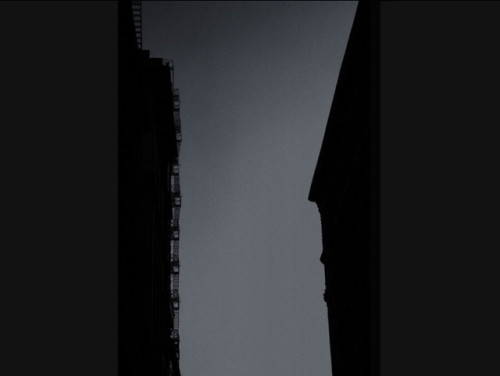
Jocelyne Alloucherie, photography.
During the Viet Nam war, there was a lot of repressed material that uncontrollably surfaced throughout the country. By the time of Reagan it was effectively, for the most part, re-buried. It is my sense that this dangerous unconscious material is surfacing again, in new ways and with new effects.
It is important, when discussing the psyche, to bear in mind that it is a product of history, a crystallization of history. This brings up the de-politicizing of psychoanalysis when it migrated to North America, and its attendant medicalization. But more on that below, too. My belief is that culture *is* political, but it is also true that objective political critique often under mass cultural enclosure, is fobbed off onto a cultural theory that is at its origin utterly apolitical.
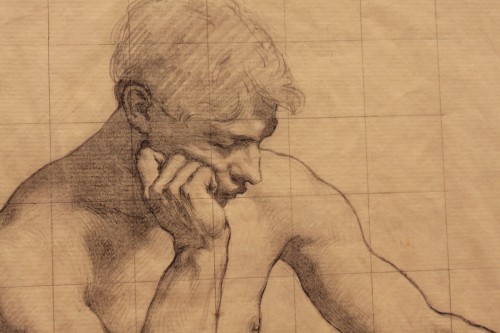
Kenyon Cox (19th century, detail).
But before returning to this idea of the hidden historical, I wanted to look at something else in contemporary culture that I am finding is directly related to this intentional burial of psychic material. That is, the idea of really ‘looking’. But this in turn links to questions of attention and focus, and to interruption and to, I guess, all the things I usually write about. But what is clearer, now, is that being able to look, clearly, without undue effort; the way in a sense craftsmen or farmers or sailors look at their corner of the environment, is a lost discipline. Except its not a discipline, it’s not anything. Or rather, what it is has to do with what it is not. That is the conundrum. And this is a almost tertiary effect of the Bernays revolution that began in the 1930s. The rise of advertising, and eventually of marketing. For Capitalism must create needs, that is basic. It is a machine for manufacturing desire. And as such it must work to train people NOT to see, not to hear, not to listen…except in certain ways and to certain things. I don’t believe audiences for political debates, for example, really listen to what is said. They take in a primitive sort of gestalt. It is about style, and the various, almost countless, codes of meaning beneath the first tier style code. That first tier is made up of things like Donald Trump’s hair, or Rand Paul’s bad fitting suits, or Bernie Sanders self consciously ruffled appearance and uncombed hair. (on a personal note, I have NEVER trusted men who can’t bother to comb their hair. End note.) Or about Hillary’s wrinkles or Huckabee’s cartoonish Puritan pastor.

Evi Keller
I wrote last post that David Lynch was only representing the representation. A simulacra of a simulacra, in a sense. This started me thinking in terms of why certain images, artworks, feel manipulative, and others do not. Its not a simple or easy question, either. One cannot reduce it to just manipulation, for their are qualities of artifice. Why does Gregory Crewdson feel so arch and manipulative, while a Joseph Schulz — a photographer who also computer manipulates his images, feels far less so. Awoiska Van der Molen, perhaps one of the best three or four living photographers, originally caught my attention because of the patience in her vision, the waiting, the allowing of things to fall away in a sense. The photos always feel as if, firstly, they are asking to be trusted. And the viewer instinctively does trust them. I don’t trust Thomas Ruff, but, I also greatly admire and respect Ruff’s work. I am not sure, though, how far that respect goes. For in the end, a photographer (to name another favorite of mine) like Lewis Baltz is felt more deeply. The world, he is saying, does not need additional affects. Baltz best work is made with this sense of ‘not having to make huge effort’. They are effortless only because Baltz has already spent decades putting in effort, an effort to really *see*. Sam Laughlin, Frederike Von Rauch, are also unique in their clarity and lack of the coercive –that which one finds almost always in commercial photography, and often in fine arts photography, too, because it now just a habit of seeing. But photography is always mediated by the camera itself. This inches into territory that Vilem Flusser writes about. The idea that what he calls ‘technical images’ are actually metacodes of texts (scientific texts mostly). Instead of myths you get programs. Whether this is right, or not, the fact is that images produced technically, today, have reintroduced a level of magical thinking. Except that it is a de-mythologized magic, and the implications of that are huge.
“Nothing can resist the force of this current of technical images — there is no artistic, scientific, or political activity which is not aimed at it, there is no everyday activity which does not aspire to be photographed, filmed, videotaped.”
Vilem Flusser

Awoiska van der Molen, photography.
The idea of being able to again see clearly, is, I believe, something haunting contemporary society. The desire for therapy, seen in both clinical psychology, and in the self-help industry, is usually misdirected at the individual, rather than at social relations. The traumatized self is embedded in society and it is society that is sick, and it is society that is making the individual sick. Most therapy however starts from an idea that the individual is somehow *ill* and that this state of illness has to do with an inability to integrate into the social. Freud himself observed that individual psychology is also always social psychology. But the confusion that surrounds social critique and psychoanalysis comes from both Marxists and Freudian revisionists. Russell Jacoby remains the very best critic of what got lost in Freudian theory when it traveled to the United States. And also, as he wrote: “A conversion takes place between the liberal psychoanalytic revisions of the neo-Freudians and the anti-psychoanalytic Marxism.” For western Marxism the question has always been why a revolutionary subject did not appear.
It was Freud, in fact, who suggested that it was only partly true that human ideologies were not only the product of the superstructure of economic conditions. And this because man, and the psychic formation (emphasis on super ego here) live in the past as much as the present, and that past is sedimented in multiple layers of the subject, and resists change as much as possible. Horkheimer wrote of a false consciousness that allowed for men to endure economic and social relations that contradict their interests, that they have ‘outgrown’, and that no objective reason fully explains it. That said, the more pronounced trend over the last sixty years was to see the suffering of the individual as curable by individual therapy — the revisionist position was one that totally erased social relations unless of a very limited order. Society was ignored. The group was a very small group.
“The permanent emergency of the individual blocks the permanent social solution.”
Russell Jacoby

Karl Blossfeldt. Photography.
Jacoby goes on to say that it is a reified and petrified thought on the left that ends up spending more time sorting out their friends (on the left) from figuring out social reality. But part of this is the cost, often ignored in a sense, of all oppositional thought in this ever more conformist culture. Marcuse pointed out that Marx was clear about abolishing class property and alienated labor, not property and labor itself. But this all returns to the damaged individual in an ever more oppressive neo-police state. The threat of punishment by the authority structure infects everyone, even if only unconsciously. (Worth reading Marx on primitive communism here). So, culturally today one of the lost abilities is actually that place at which vision and history come together. If the psyche forgets the sediments of history, so the ability to *look* at images, technical or otherwise, is superficial and shallow. This comes back to this almost Taoist notion of effort.
“In the beginning one will need to
exert effort in order to be without effort, and to exercise a purposeful
mind in order not to have such a mind, just as, in order to forget,
one at first needs to remember that one should forget. Later, however,
the time comes when one must discard the effort to be without
effort, and the mind that purposefully tries to have no purpose, just
as one finally forgets to remember that one has to forget.”
Fung Yu-Lan, on Ch’anism.
Maureen Katz, a psychiatrist working in Oakland I believe, asks “How does witnessing these spectacles create terror and affect our ability to think and fashion our own identities as spectator or participant, perpetrator or victim? What are the social and political environments that contribute to our psychological defenses, and how can we see evidence of those defenses and their breakdowns” And this is the forgotten realm for the analysis of contemporary Capitalism. Eventually defenses form against the onslaught of threat and intimidation. The U.S. today has to be among the most threatening cultures in history. Only the threats are embedded in the spectacle. The threats are often part of a fabric of stigmatizing and shaming. Of course unless you are black, in which case the punishment becomes acutely material. The war on the poor is, in general, simply the place where violence is accepted — and it is the violence of the state and its subcontracted thugs, the police. The violence toward black Americans is now enshrined as a ritual of purification for white people. And as I wrote last posting, this society of definitions and facts encloses discourse in a shroud of faux benevolence. The result is an almost schizoid relationship to others, and to the abstract idea of the state. For the affluent white classes their vision is the most mediated I suspect. But, the mechanisms cut across the entire population, really. Nobody escapes.

Luc Tuymans
Allow me a short digression here. The architectural always looms in all discussions of art and culture today. And whenever discussions turn toward architectural blight, I get a bit uncomfortable because certain buildings or developments become scapegoats for what is a systemic problem of income inequality and lack of social services. The best example is the Vele de Scampia (1962, Napoli) which wasn’t really a bad design at all. The problem was administrative corruption, shortage of funding for low income tenants, etc. On the flips side, for example, The Red Road estates in Glasgow (now being torn down I believe) represent everything that is wrong with public housing design. The Northampton Greyfriers Bus Station is an often cited example of the worst of mid century brutalist public building. The list of architectural atrocities can start with Torre Velasca in Milan, Italy, built in the 50s by BBPR, or the Scottish Parliament Building, designed by Enric Miralles, or the Kosovo National Library (I urge you to look-up these monstrosities), or Strata SE1 at Elephant & Castle (2010 by BFLS), the Slovak Radio Building in Bratislava (1982), which I had the misfortune to visit once, or the Verizon sky scraper in NY, Trump Tower, or the Palace of Culture in Warsaw. The list goes on and on. Take any average L.A. office building, like the one I post an image of below…these structures saturate southern California.

4055 Wilshire Blvd. LA.

Mirador Sanchinarro, (MVDV), Madrid. 2005.
The violence of the system is inscribed in its buildings. And it is inscribed in a variety of ways. Milton Court or Pelham Parkway, Bronx, are only the obvious examples of abandonment by the system, while the aesthetic disorder of the Boston City Hall is no less destructive psychically. For really, there are very few major architectural projects that are not predicated on intimidation and power. The Antilia apartment building in Mumbai is one of the three most expensive residences in the world, and one of the three ugliest. In strange ways though, buildings often take on a quality of the mythic, even if unintentional. North Korea’s Ryugyong Hotel is oddly unreal, and its unreality is almost seductive.
But back to this notion of seeing, of looking, and art. This quality of manipulation exists pre-Capital, of course, but I think it likely was called something else. A society that in general cannot process art works, cannot experience them as they cannot experience their own lives, is living in a dead zone.
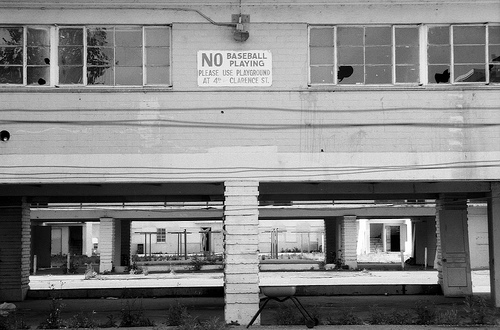
Aliso Village, Los Angeles.
One of the things that is becoming increasingly clear to me is that the current system of advanced capital and militaristic neo colonialism has encouraged, even on the left, tendencies toward a punishing puritanical mind set. The inner cop, in a sense. That said, the criticism itself, from the left, is invaluable. For the mainstream culture today the idea of a genuinely critical position is anathema. Criticism is carefully contained in mainstream media to only the most inconsequential topics. And even then, it is dishonest almost by habit. The liberal white class in the West is constricted by reflex responses. I often feel most people are talking aloud to themselves, not to each other.
This is interesting if looked at from a Lacanian perspective. Mathew Sharp wrote: “Lacan articulates this decentring of desire when he contends that what has happened to the biological needs of the individual is that they have become inseparable from, and importantly subordinated to, the vicissitudes of its demand for the recognition and love of other people.” Our desire then, if I revise Lacan a bit here, is in several registers. The later, learned desire, the desire of what the other desires, is then, in contemporary society, part of endless playback loop. For the biological strata is now part of a larger register of exchange calculation, and of displaced resentment and anxiety. In Poland the joke was that if your neighbor got a new car, you did not pray that you, too, would get such a car, but that today, your neighbor would go out and crash his new car.

Zel Nunes, photography.
Today, the surfacing of the most fiercely repressed material, is found attached to those images and stories in which the most abject and pitiful and vulnerable appear. The dead Syrian child, now quickly appropriated for various sentimental pro-imperialist narratives, is also the occasion for the most repulsive racism and bigotry available to humans. I, personally, have heard several times something close to “why don’t they go back home and fix their own country”. Never mind the stupidity for a moment, lets think about this idea of going back home. Of what that actually means to those uttering it. Or rather, that this means something only to the person uttering it, who is talking to him or herself. Vijay Pradshad observed that it seems fine, and profitable, for capital to cross borders, just not people. And especially of course black and brown people. The colonial subjects. The idea of the white westerner is that home is a fortress, a castle, and inherently hierarchical — a man is king in his castle, etc. Home is now stripped of allegorical meaning in the mind of the average white Westerner. It is simply an abstraction employed as a logical connective to the expression of aggression. It is my duty to defend my home, etc. Such bromides are the stuff of cadet training, or boot camp instruction.
It is this quality of alienation that feels so pervasive in reactionary and liberal discourse, today. The alienation of a subject whose desire is for a concrete reliable definition of self, and who struggles desperately against the overwhelming sense of lack of self. William Empson wrote a long essay on the Faces of the Buddha, which was sadly lost. But the notes for it remain. Sharon Cameron, from her essay on Empson’s Buddha notes: “…a subjectivity that isn’t a subjectivity, a person who is
impersonal or who aims, though cannot will, to be so; or who discovers the
inevitability of being so; or who represents the inconsequence of personality
before a force that leaves personality intact but, notwithstanding its persuasive
outlines, in effect always trivial. But if Empson’s Buddha faces expose
certain elements in the representation of an impersonal person, they consistently
omit this one: In the icons Empson describes, the “passive power” affiliated
with the incompatibilities diffused throughout the Buddha face is never
linked to violence. Buddha expressions bear no traces of violence—violence
being the antithesis of, the one contradictory feature exempted from, the
constellated peace of which the Buddha is the image.”
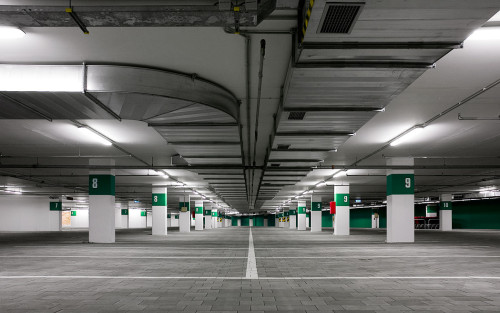
Branislav Kropilak, photography.
Empson was fascinated with Noh Drama, and with the idea of representations of impersonality — with expression that is not predicated upon control — which he also saw in Eastern music, characterized by being slower than a heartbeat. That the music of the West was always faster than a heartbeat and implied a need for control. However true or not, the point in here is the sense of congruity with the sense of impersonality in Buddhist iconography. As Adorno wrote …“To posit the body and its pleasures as an unquestionably affirmative category is a dangerous illusion in a social order that reifies and regulates corporeal pleasure for its own ends just as relentlessly as it colonizes the mind.” He adds at the end of that paragraph that aesthetics must not be abandoned, even if the terms of reference have been tainted by mass culture and fascism. What Simone Weil called the ‘impersonal person’ is the new model citizen of western Capital today. Rationality is always exploitive under Capitalism. It is instrumental. Behind this, however, lies the tensions of “the emergency of the individual”. What Empson saw as so profound in Buddha faces was the blindess that was all seeing. It was the acceptance of asymmetry. This returns the discussion to what Jacoby termed *social amnesia*. Memory driven out of mind by social and economic tensions; a planned obsolescence of the mind. But the profound contradictions of contemporary social trauma result in the appearance of cracks in the status quo. The return of the repressed, and this surfacing of repressed material finds outlets along the margins of psychic organization. It is leaking out like 10W-40 from the psychic engine block of the society. The sadism and cruelty of the impersonal person is not experienced as cruelty, but as self empowerment and agency, or whatever other slogan is handed out by mass cultural fashion.

Ryugyong Hotel, North Korea, 2011.
“Modernism is art forced into mute self contradiction; and the source of this internal impasse lies in arts contradictory status in bourgeois society. Culture is deeply locked into the structure of commodity production; but one effect of this is to release it into a certain ideological autonomy, hence allowing it to speak against the very social order with which it is so guiltily complicit.”
Terry Eagleton
Art can only be authentic (Eagleton’s take on Adorno) if it recognizes its complicity, and its compromised status. This today is a very tricky computation, for the end of modernism is long since past and the new state of telecom mass culture, post post modern, or whatever, is one in which art is cannibalizing itself in an effort out of this dialectic of false consciousness. For the problem, really, in this equation anyway, is with the loss of self — the identity where there is no identity.
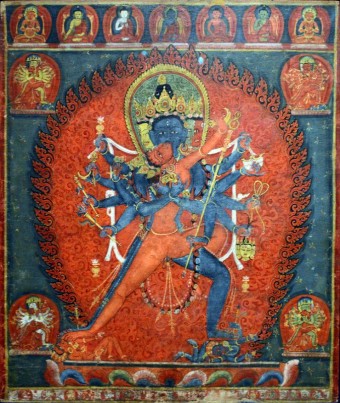
Chakrasamvara and Vajravarahi, Nepal 1575-1600
It was Marx who really first extrapolated upon the idea of ideology; that it was a kind of consciousness deformed by societal and material conditions and forces. Within this the self is falsified. But as Jacoby rightly emphasizes, this is not mere abstraction, but a result of very concrete conditions and which did not exclude what has come to be called *common sense*. For the pernicious notion of common sense is really the most ideological of concepts. Today it is embedded, deeply, with logical positivist bias. The distrust of things which cannot be weighed and measured is doubly dishonest. Firstly, it is an expression of deep anti-intellectualism masquerading as its opposite. Secondly it mystifies what is a form of myth making in science itself. The rise of the phenomenon of ‘bad science’ is almost epidemic, for one cannot open any mainstream paper or web page and not find spurious studies that *prove* one thing or another, or often, increasingly, don’t even attempt to prove anything. Lost amid all this is the conflicted subject. One that experiences a kind of mental stultification. The public, on a day by day basis, navigates through a tsunami of commodity image and micro narrative that expresses almost nothing. For the point is not in the result, but only in the capturing of attention. And the subject so captured is only dimly aware of its own entanglement in a crippling psychic cul de sac. And it is here that art still provides some kind of avenue out of this. And I continue to believe that art which can negate the prevailing system, even if (usually) through its form, and understanding of its own compromised materials, is a kind of very pertinent resistance. To use only one example, the narrative of candidate Bernie Sanders; it is, or should be, obvious that this is a cheap fable, a children’s story that only the most deeply indoctrinated would accept — and it’s not really about acceptance anyway. It’s about the secondary mimetic gloss that is layered over this fairy tale. And again, it’s not even a fairy tale, it doesn’t even rise to the level of fairy tale. For in the brand that is Bernie what should be apparent are the facts of a 28 year career in politics from a marginal and very white state where voting records make clear that the presumptive outsider has almost always, 100% of the time, voted in accordance with his party. Tacit support for Pentagon defense contracts and support for Israeli aggression and occupation are obscured by the style, by the brand. The tousled hair and the untucked shirt tail. Look closely and you see a mean little man, a passive aggressive bully, really, with the feral eyes of a supermarket night manager, or cashier. But substituting for mimesis is a litany of pre-formed excuses, expressed as common sense, as logical (the lesser evil trope) and which provide a brief unsatisfying, but still usable emotional salve. For emotional pain is inscribed on all things which include any kind of narrative about society.

Shirazeh Houshiary
Sociology became popular in the U.S. because it provided a patina of scientific rationality, all the while diverting the critical edge of Freud, Marx, and later thinkers of the Frankfurt School. The abandonment of history took place not through actual forgetting of the past, but through a re-writing of it, and hence psychoanalytically a return to the past, a regression. The increase of domination is linked to the instrumental positivist belief in progress. Underlying the rewritten past, which integrates the personal and the collective, is the logic of progress. Marcuse wrote “Intensified progress seem to be bound up with intensified unfreedom.” And there are a myriad of mechanisms of expression that are coupled to this. List making is just one example. An expression of powerlessness, the avid maker of lists is felt to be participating in a spectacle that in reality has excluded him or her. As Amy Buzby puts it; “If reason is enmeshed in oppression, external possibilities for change are undermined by the internal reproduction of domination.” Now, this is where the question of ‘seeing clearly’ is relevant. For in a sense the sensitizing of perception is achieved through the absence of effort, an effort that has been absorbed and instrumentalized (sic). Competitive effort has become effort, all effort. So, firstly there is the examination of the most obvious complicity with commodity culture. But that is far too easy, on the face of it. And it is also impossible. One cannot see until there is an ability to listen, and before that to read, and then one can reverse all these strategies — and on and on. And this is where the idea of collective solidarity becomes individual emancipation. And it is, I think, what Empson found so compelling in the asymmetry of the Buddha’s face.
The more one organizes socially, in projects of resistance, the more genuinely individual one becomes. One is never more oneself than one is submitting to collective dreams. It is that process of shedding the toxic skin of propaganda and commodification, of reification, that allows for a certain emergence of self.
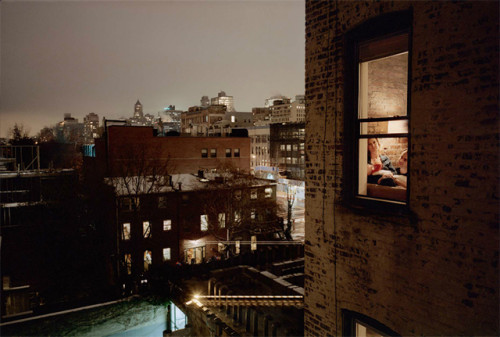
Gail Albert Halaban, photography.
From Susan Babbitt’s recent essay; “When BBC reporter Iain Bruce researched the Chávez revolution, he noted Venezuelans’ frequent use of the word ‘surgir’ (to emerge, to spring forth). Venezuelans in the barrios described wanting to emerge. And indeed, a whole section of Venezuelan society, “millions of people who had been buried in silence, obscurity and neglect, have suddenly ‘emerged’ from the shadows and established themselves as actors, as protagonists both of their own individual stories and of the nation’s collective drama.”
Metaphor, allegory, and the material world merge in an idea of ‘surgir’. It is also an emergence from falsified history.
Babbitt also writes : “The ancient Chinese philosopher Chuang Tzu (fourth century BC) maintained that to lose one’s life is to save it and to seek to save it for one’s own sake is to lose it. Eastern philosophers in particular understood attachment to self, and obsession with security, to constitute the most radical form of alienation. One cannot know others that way, at least not most others. Even worse, one risks not knowing they are there to be known.”
This is the core of Taoist thinking, in a sense. Not the westernized Taoism of new age passivity, but even if reductive in the above description, it is still valid. And the aesthetic branch of this touches on something Artaud intuited. The performer, the actor on stage, is only most authentic, most himself, when he has lost himself. And this idea, in theatre, is linked to a dialectic of individual and collective.
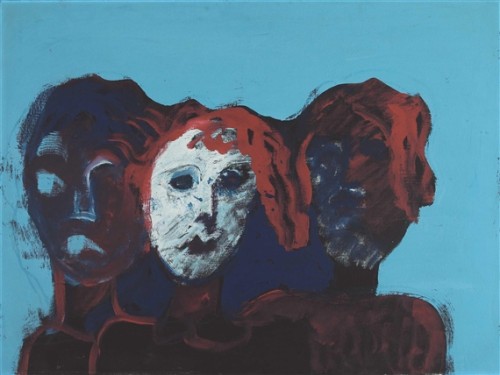
Tano Festa
Again from Sharon Cameron’s essay on Empson…quoting both the Pali suttas and Ralph Waldo Emerson;
“In the absence of distraction, one is able to discern the changing nature of bodily sensation and the contingent (nonautonomous) nature of bodily sensation (to see that nothing can arise alone without the support of other things on which its existence depends)10—that is, the nonsubstantive nature of bodily sensation. And similarly of feelings, mind states, and objects of mind. Experienced rather than conceived, all are empty phenomena, whose insubstantiality could not constitute individuality. What body, feelings, mind
states, and mind objects are empty of is personal identity. The reduction to sensation without thoughts that appropriate it (or a seeing through such thoughts) unsocializes perception so that its objects are particles—like driving rain, or snow on the television screen—nothing that could have meaning: “When . . . regarding things seen, heard, sensed, and cognized by you, in the seen there will be merely the seen, in the heard there will be merely the heard, in the sensed there will be merely the sensed, in the cognized there
will be merely the cognized, then . . . you will not be ‘by that.’ When . . . you are not ‘by that,’ then you will not be ‘therein.’ When…you are not ‘therein,’ then you will be neither here nor beyond nor in between the two. This itself
is the end of suffering.”
The ingrained habits of thought in contemporary culture are all directed toward passivity, toward compliance. And the Western appropriation of Eastern thought has turned it into its opposite, to a form not of emergence but of suffocating disinterest. The mind directed toward shopping as an expression of ownership, and ownership as a form of individuality, is one of mental lethargy. And Western versions of Buddhism treat it as simply another item to be purchased and owned.

Amy Lincoln
There is a danger in formulations of impersonality, however. And that is that such detachment of mind can quickly regress to an archaic narcissism, an infantile omnipotence. Amy Buzby quotes Leonard Shengold: “As knowledge increases and the universe becomes transformed with repeated experiences of frustration and ‘no’ — as the unpleasurable and the not-me become part of the contents of the mind — the initially infinite inner world shrinks, as does the global sense of self, into a registration with the child’s mind of the complexities and infities outside the self. The space in the external world occupied by the self becomes for the most part pitifully small.” We cannot *have* everything, and the problem here is not that inability, but the idea of *having*. Freud was always addressing the destructive effects of a repressive order. Something he never saw as eternal. The idea of emergence, of a self that is socially connected, comes out of an expansive erotic desire. Desire is not the desire to have, however. Compassion and empathy are the very things that a repressive and authoritarian society work to eliminate. For at its heart, the fascist is always a puritan. A punishing force that cannot tolerate the uninhibited energy of Eros. And compassion for others is bound up inextricably with our desire. Emerging into a collective compassion, a sharing world, is the first order of prohibition for the fascist state. The substitute figures of heroic violence are recycled endlessly. And, as part of this propagandistic bombardment is the reinforcing of a model of individuality which is actually anti-individual. It is the manufacturing of robot selves.

William Empson
One of the regressive aspects of the therapy industry is the creation of groups which are structured like individuals. The group is there to reinforce a false individuality, and to pass judgement. Or, worse perhaps, to pretend to not pass judgement. This is the ethos of the liberal — a granting of forgiveness where no crime or transgression has occurred.
It is in culture and art that emergence finds traction. This idea of seeing clearly then is one in which the mimetic is allowed the space — psychic and temporal — to integrate the image or story, not to *have* it, or catalogue it. As soon as one buys something it, one has killed it. Under a commodity system, one must pay for everything, but one can pay and still not have. But there are countless issues surrounding all of this. Guilt, aggression, regression, and depersonalization. For the left, the challenge culturally is to release itself from that inner cop. Becoming the judge in a court of opinion is retrogade, it is becoming the messenger of just another form of punishment. And of self absolvement. I continue to feel that the principle of exclusion is perhaps the most pernicious and harmful of attitudes. The demand for agreement is a double edged sword. Repressive tolerance or authoritarian judgement. Anger is healthy, and I think more people should be much angrier. But anger does not need to become exclusion and the passing of edicts.

John, interesting comments about the modern equivalents of Pruitt Igoe & Cabrini Green. Looking back further, I’m wondering if you see a connection between these developments and Corbusier’s Unité d’habitation structures?
@george…..
Good question and one that several writers touched on. I think there is, and I have no simple take on this, but I think there is an influence there, but its not a simple one. Its a matter of both something inherent in Le Corbusier’s vision, of purifying the eye and something vaguely totalitarian in his work — and, a reductive mis-reading of his work. Both. But in general there is a real question about putting people in boxes. Just that. And the implications of that.
The comments on Sanders are spot on and the last time I heard some “liberal” friends go on about how wonderful he is I just had to step outside. Clearly he’s not a threat to the establishment — he’s managed to avoid a Wellstone crash of convenience. Though I imagine mythology developing around Sanders that he insists on driving himself everywhere– and that his car is a 1984 Volvo with the original price sticker still on the window. Never bothered to remove it.
Are you familiar with the writings of David Bohm on Dialogue? it is about groups of people thinking together.